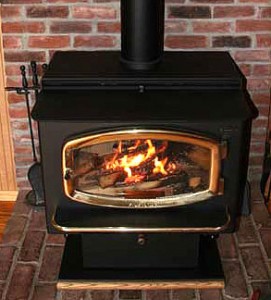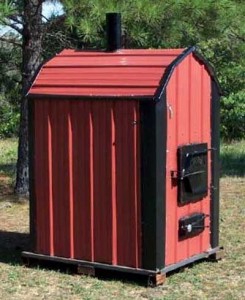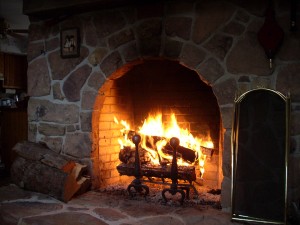How to Heat Your Home Without Electricity
Without electricity or natural gas, heating a home (especially in colder climates) can be difficult. Most modern homes rely on one or both of these sources for all heating duties. Fortunately, these conveniences only became mainstream within the last 60 years. Prior to that, people figured out ways to live comfortably in various climate zones. Even today, some people choose to live an off grid lifestyle and are able to do so without electricity or fuel supplies.
Wood Stove
The easiest, and by far the most popular, method of heating your home in a survival situation is a wood stove. Typically made from iron, a single wood stove can heat an entire home. In most areas of the country, firewood is readily available. A few days work chopping and splitting wood can yield a couple months supply of wood.
Some wood stoves are placed directly in a central area of the home. This is the most effective method, especially when using a smaller stove. The only drawback to  this method is that sparks and burning embers can fall out of the stove and potentially cause a fire. For this reason, it is best to place a wood stove in an area of the home that is a safe distance away from flammable furniture or upholstery. The stove can also burn skin quickly; a consideration important for homes with small children.
this method is that sparks and burning embers can fall out of the stove and potentially cause a fire. For this reason, it is best to place a wood stove in an area of the home that is a safe distance away from flammable furniture or upholstery. The stove can also burn skin quickly; a consideration important for homes with small children.
If you are considering a wood stove, make sure you install a proper chimney to allow poisonous smoke to escape the home. Drilling a hole in the roof is the most common method. If you already have a chimney in your home, an insulated pipe can be run from the wood stove to the chimney instead of cutting a separate hole.
Wood stoves use a lot of wood; especially in the cold winter months. Even when you go to sleep at night, the fire often extinguishes leaving your house cool in the morning. One way to increase the length of time between refills is to mix dry, seasoned wood with green wood. The dry wood will burn immediately and dry out the green wood as it does. By the time the dry wood has burned out the green wood is dry and burns easily. By mixing the wood in this manner, the stove can maintain a constant temperature output for longer periods of time.
Wood stoves can also be used to cook food and heat water. The hot outer surface of the wood stove can easily cook food using standard pots and pans. Copper tubing filled with water can be run near the furnace to heat up water for bathing. In a survival situation, versatility is essential and the wood stove has many uses in addition to its primary duty as a heater.
In homes with a basement, the wood stove can be placed down there to reduce the risk of fires and burns. The heat from the stove naturally rises and can heat most homes even from the basement. Many people have had success routing the heat from the wood stove through the duct system already in place for a standard furnace. Care must be taken that noxious gases are not being introduced into the home and some sort of forced air system would have to be installed to move the hot air through the house effectively.
Wood Furnaces
Unlike wood stoves which are designed for use inside the home, a wood furnace is a larger unit designed for outside use. Due to their larger size, furnaces typically only need to be refilled once a day. The risk for fire or accidental burns is also minimized.
 Heat from an outdoor wood furnace is transported into the home using ducts. These ducts should be buried underground for maximum efficiency in cold weather. Commercially available wood furnaces often have tubing integrated that is designed to heat your water as an added benefit.
Heat from an outdoor wood furnace is transported into the home using ducts. These ducts should be buried underground for maximum efficiency in cold weather. Commercially available wood furnaces often have tubing integrated that is designed to heat your water as an added benefit.
The only drawback to a wood furnace is that if you have not already set it up prior to an apocalyptic event it is unlikely to be a practical solution for you. They are extremely large and heavy making transportation difficult at best. However, if you install one now it will be ready for use whenever needed by simply lighting a fire.
Fireplaces
Traditional fireplaces have been used to heat homes for centuries. Unfortunately, they are better suited as an ornamental piece than as a serious home heating solution. A fireplace is better than having no heating solution at all but they are known to be as much as 70 percent inefficient meaning that most of your heat is going up the chimney with the smoke and ash.
 If you do plan on using your fireplace to provide heat, make sure you have a high-quality flue that can keep cold air out when the fireplace is not in use. Also consider putting reflective material in the back of the fireplace. This helps to radiate heat back into the home instead of up the chimney and out of the house.
If you do plan on using your fireplace to provide heat, make sure you have a high-quality flue that can keep cold air out when the fireplace is not in use. Also consider putting reflective material in the back of the fireplace. This helps to radiate heat back into the home instead of up the chimney and out of the house.
Other Options
As you can see, wood is the preferred fuel for off grid living due to its plentiful supply throughout much of the world. There are other options for heating your home as well although some may not be very sustainable for long term survival.
One method that is sustainable is the sun. Specifically, passive solar heating uses the intensity of the sun to heat homes quite efficiently. Assuming you have a well-insulated home, you already have everything you need to take advantage of passive solar heating. Simply by opening the blinds or curtains of sun-facing windows during the day you can increase the temperature inside your home significantly. Proper insulation helps to keep that heat in during the night hours when the sun is no longer heating your home.
In some areas of the country, this method of heating can be used almost exclusively while in others it is an efficient way to lessen the load on the wood stove. Either way, the sun is an excellent source of home heating and shouldn’t be ignored.
Portable propane heaters also work well. However, due to their reliance on fuel they are not considered a sustainable asset. Propane can be stored for years without deteriorating unlike gasoline or kerosene making it the only viable choice if you decide to use fossil fuels at all. Eventually even your propane supply will run out so this is best as a short-term solution or for situations when the wood stove isn’t enough.
Home heating without electricity or gas may seem like a lot of work. The truth is that people lived in this way for thousands of years prior to the advent of modern technology and infrastructure improvements. A serious survival situation will set society back to a more primitive state and heating your home with these methods is the only way to ensure long-term survival.
Survival MD (Best Post Collapse First Aid Survival Guide Ever)
Backyard Innovator (A Self Sustaining Source Of Fresh Meat,Vegetables And Clean Drinking Water)
Blackout USA (EMP survival and preparedness)
Conquering the coming collapse (Financial advice and preparedness )
Liberty Generator (Build and make your own energy source)
Backyard Liberty (Easy and cheap DIY Aquaponic system to grow your organic and living food bank)
Bullet Proof Home (A Prepper’s Guide in Safeguarding a Home )
Family Self Defense (Best Self Defense Strategies For You And Your Family)
Sold Out After Crisis (Best 37 Items To Hoard For A Long Term Crisis)
SOURCE : www.survivopedia.com




You fail to mention that a new wood stove law will take effect in 2014. If your wood stove emissions are greater than 7.5 grams per hour you will not be allowed to run it. The Kimberly Stove that we sell on our website it already certified for this new law with the very low emissions of 3.2 grams per hour. The Kimberly Stove is so efficient that it it certified in Washington State.
The 2014 law is not for existing in place stoves. It is for new manufacture units.
PS- I love the Kimberly Stove
Every wood furnace I’ve ever seen requires power (110VAC) to run. The power is for the pump to make the heated water flow/circulate and to operate solenoids and valves and baffles and vents. At the very least, you need to operate a pump for water circulation.